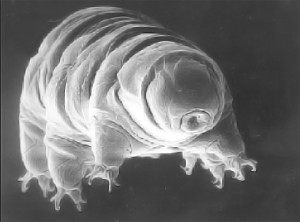Have you ever seen anything so microscopically cute?!?
Let me introduce you to the Tardigrade, whom you may already know as the Moss Piglet, or the Water Bear. It’s very likely that he lives in your backyard.
Tardigrades can grow up to about 1 millimeter in length, and lumber around on those eight legs of theirs, sort of like a bear with extra limbs. While they must live in water to maintain proper balance with the environment around them, they can inhabit just about any climate on earth. In fact, the organism is able to go into a hibernation-like state to survive temperature fluctuations, and is thought to have a comfort window between -320 and 300 degrees Fahrenheit.
These little guys are omnivorous, feeding on the cells of plants and animals. Some even accuse them of cannibalism… never trust a man with a moss piglet farm.
Tardigrade populations have both male and female members, though the males can sometimes be very small and scarce. When it comes time to reproduce, water bears are capable of doing it our way or like the fishies. Not only cute, they’re open minded too.
You Can Catch Them!
If you want a water-moss-bear-piglet to call your very own, it’s as easy as going outside. Here’s how, courtesy of Carleton College:
- Collect a clump of moss or lichen (dry or wet) and place in a shallow dish, such as a Petri dish.
- Soak in water (preferably rainwater or distilled water) for 3-24 hours.
- Remove and discard excess water from the dish.
- Shake or squeeze the moss/lichen clumps over another transparent dish to collect trapped water.
- Starting on a low obejctive lens, examine the water using a stereo microscope.
- Use a micropipette to transfer tardigrades to a slide, which can be observed with a higher power under a compound microscope.
Personally, I just love how they look like balloons or blimps, and think they’d make great shapes for a pillow or piñata.
Sources:
Carleton: Microbial Life Resources

